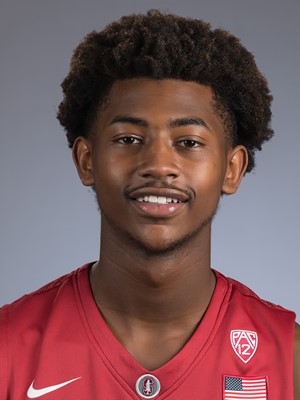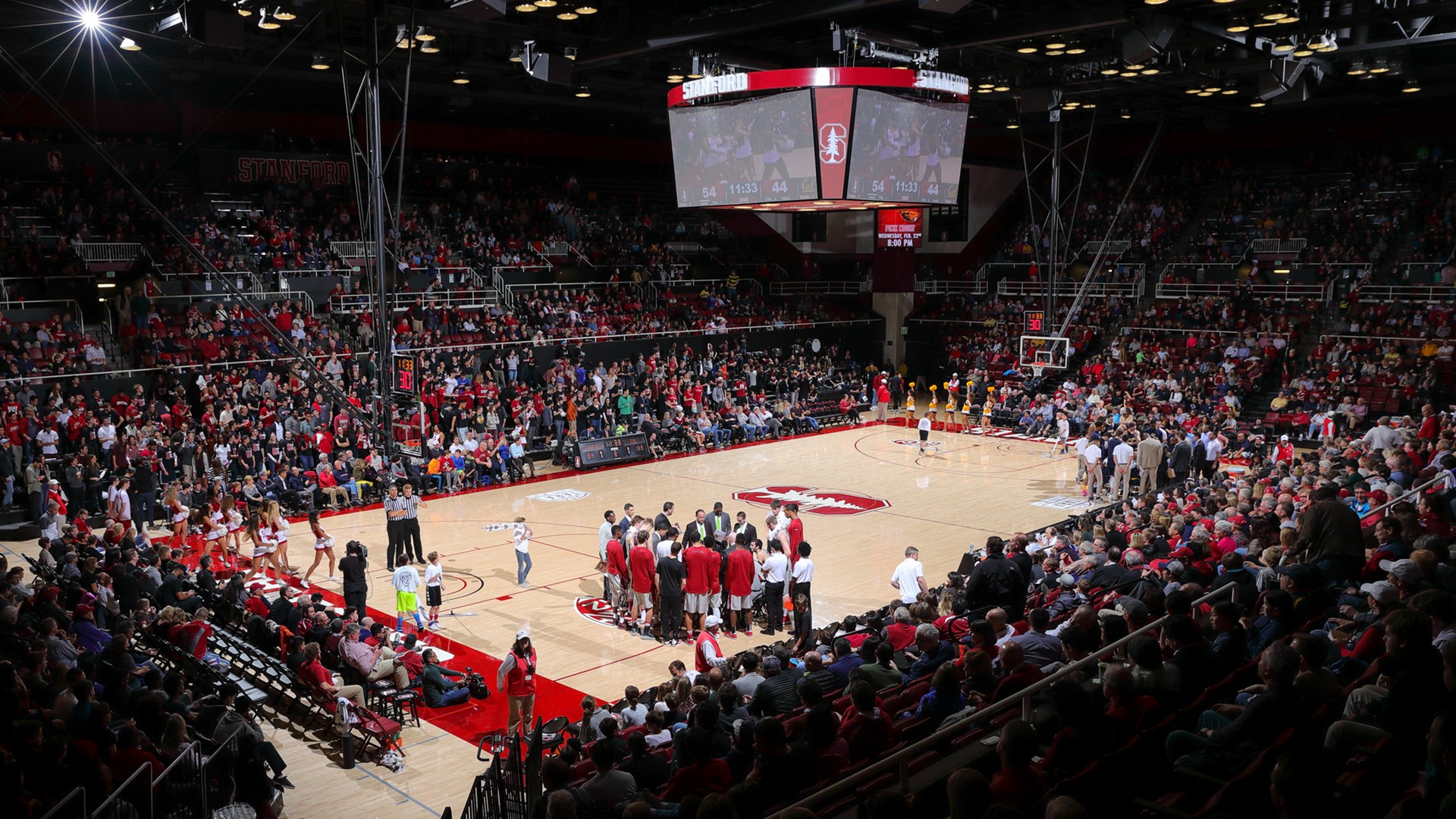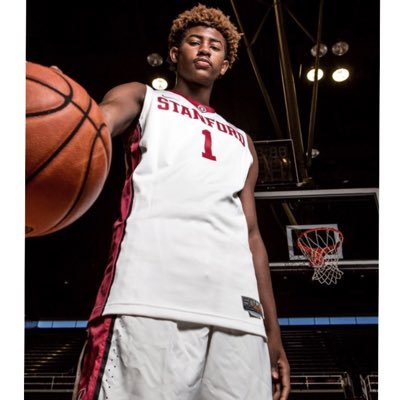
On his way to the Stanford media room for the first time, Daejon Davis is all smiles. He waves to every staff member he walks past. He pokes his head into the sports trainer’s office.
“Get ready for what’s coming!” he says, laughing. Allegedly, the friendly players-versus-staff wiffle ball matches can get pretty intense.
To any observing eye, the 6-foot-4 four-star, top-50 recruit is already a big part of the Cardinal family. Yet just over four months ago, things could have turned out very differently. Previously committed to the University of Washington, Daejon was set to don the purple and gold. Even though he would decommit from Washington, Daejon was still determined to be a Husky as he again committed to the school.
Basketball was an early love for Daejon, as he can recall. “When I was 5 years old I was taken to a park,” he says. “My stepdad handed me a basketball…I started shooting hoops and literally didn’t do anything else the whole time I was there.”
After discovering her son’s interest in the sport, Daejon’s mother was quick to sign him up for the local Boys & Girls Club. From then on, his passion for the game stuck, never wavering to other sports. “My mom wouldn’t let me play football…I was in track for half a season but I was just like, ‘Nah, I don’t like this,’” he says. “It was always pretty much only basketball.”
Living in Seattle with its huge basketball community gave Daejon many influences to go down this path. With a mother who attended Garfield High School, a state basketball powerhouse, he grew up watching the city’s young stars in admiration, such as Tony Wroten, Peyton Siva, Joshua Smith and Tramaine Isabell, all of whom earned statewide honors during their successful high school careers.
“We watched these players go through the same process I went through: start at an in-house league, AAU, then we get on the circuit—I always dreamed of playing in the circuit and being what they were,” he says. “That era of basketball players made me want to go to Garfield.”
Not only did he have high school role models, but Daejon could also see evidence that his ultimate dream of making it to the NBA was possible. Basketball was nearly as entrenched in Seattle’s culture as coffee, so it was no surprise that a few dreamers were able to make it all the way. Professional basketball players from the area, including Jamal Crawford, Brandon Roy and Will Conroy, often would return to their roots and witness the emerging sprouts that would potentially take their places in the future.
“[They] helped motivate me to be like them—they would always come back to the community and hang out with us as little kids,” Daejon says. “The fact that I was able to receive such support at home kind of makes me appreciate home more than anything.”
Still, despite self-motivation and inspiring influences, it was an upward climb to grasp that torch passed down from his Garfield idols. Some of that pushback came from one of his biggest supporters—his mom. Always looking out for her son’s future, she had already had Daejon enrolled in private school in eighth grade and encouraged him to apply to other private high schools. Little did he know that it was this focus on academics that would bring him to Stanford several years later.
“I got accepted to Lakeside [Private School] and my mom was like, ‘You’re going here,’” he says. After some initial resistance, he agreed to spend two successful years of high school there. Junior year, then, was the turning point in his basketball career.
“My mom finally allowed me to transfer and that’s when basketball really took off for me,” he says, smiling. “From that point on, it was just that much more fun to be doing it for a culture more than just myself.”
As he went into a historically great Garfield school that had won 11 state championships and produced NBA-level talent, it would be understandable if Daejon felt some pressure as a newcomer trying to prove himself. Not him.
“Pressure?” he says with a confused look. “No. It’s basketball. I’ve been playing all my life. At the Boys & Girls Club—same basketball…if you put in the work, you should be confident of your skills no matter what level you’re at.”
Daejon kept this message to heart as he joined the Garfield varsity team but surprisingly didn’t start right away.
“I was second-team All-Metro as a sophomore, so everyone expected me to come in and start, but Coach [Ed] Haskins made me work for my spot,” he says. To win his coach over, he had to do more of the little things to prove himself. “First game at Les Schwab [Invitational], I had a lot of points, but something like 18 rebounds. Coach was like, ‘He’s really working hard and not even caring about his scoring,’ so after that game he put me in the starting lineup.”
To him, basketball has always been about two things: winning and having fun, which often went hand in hand. “I always wanted to be the best,” he says. “I’m really competitive.”
With his win-first mentality, Daejon was always willing to go the extra mile for the sake of the team.
“I always knew I was an unselfish person,” he says. “You get way more joy out of winning a championship with your team than winning an MVP trophy.”
More than anything, he learned to embrace each aspect of the game and the excitement that came with it. Basketball became more than a sport—it was an identity. “Everything about basketball…everything is just so fun,” Daejon says. “It’s crazy how each level just gets more and more people watching you, and I really enjoy that.”
In no game did more people watch him than in this year’s Washington 3A State Championship game against the No. 1 team in the nation, Nathan Hale. As crowds of scouts and fans flocked to watch Nathan Hale’s star, top recruit Michael Porter Jr., Daejon felt right at home.
“I’m just out there on the court. I don’t care who’s watching,” he says. “There’s not much pressure playing basketball unless you put the pressure on yourself. It’s supposed to be a fun, competitive game.”
Unfortunately for Daejon, his team did not get the result he hoped, losing 68-51. While the loss still lingers in his mind, it only serves as motivation for the future.
“Second place does not feel good,” he says. “It’s just a learning experience—I just know if I ever get to that point again, I don’t want to lose.”
Despite the loss, Daejon looks back on the year as a success. “The entire season was so much fun,” he says. “The whole community rallied behind us because of all the hype around Nathan Hale—it brought the community closer.”
Overall, high school was a chance for Daejon to learn his most important lesson to date: to believe in himself. “Just the whole process of high school from where I started to where I am now is all a blessing,” he says. “People always said, ‘What are the odds you’re going to become a Division I basketball player?’ ‘What are the odds you’re going to make the NBA?’ I mean—odds are out there and…if I really want something, I work as hard as I can to get it.”
“I proved to myself over and over that I can pretty much achieve anything I want, as long as I put the work in and I’m confident in my abilities.”
Like many kids who were focused on the NBA, the thought of college basketball didn’t come until he got older. When Daejon reached middle school, he witnessed some of the high school players he followed go off to ACC schools. “Then as I got into high school, the Pac-12 began to get more competitive—a lot of guys were staying home,” he says.
To get noticed around the country, Daejon would play in the Nike EYBL (Elite Youth Basketball League) circuit outside of high school.
“It’s a different atmosphere. High school is more of a time to play for your school pride and have your college coaches who are recruiting you come watch you play,” he says. “AAU is typically for getting more hype around your name, getting noticed by coaches more—it’s a bigger group of games…mostly another place to have fun for me.”
Over the course of his development, he was able to build some key relationships at these tournaments and around town, notably with former Washington coach Lorenzo Romar. “Always someone who’s been around me. From when I was young, working out with my cousin who attended there…at the gym, AAU tournaments, Boys & Girls Club,” he says. “Had many conversations with [him] prior to even being recruited by him. Ask me how I’m doing, how’s basketball doing, how’s school doing.”
Romar’s ability to develop strong relationships with players helped him build UW’s top-notch recruiting class that included Daejon as well as No. 1 prospect Porter. Daejon first committed to his hometown school in August of 2015 before backing out the following April.
“Me and my mom weren’t sure,” he says. “We had never been on another college campus. We loved everything about Washington, and it wasn’t a decommitment—I didn’t take them off my list like I didn’t want to go there anymore.”
Daejon simply wanted to go out and explore more options. “Every time I was asked, I was so happy to be recruited I was like, ‘Oh I’m okay with going away from home,’ but I never really knew what it would be like to be away from home.”
So Daejon decided to keep it on the West Coast and, for the most part, in the Pac-12, with a final five of Stanford, Arizona, Oregon, Washington and Gonzaga. “Every school except Stanford was there from junior year on,” he says.

There was a good reason, however, that Stanford was late to the party. Former Stanford head coach Johnny Dawkins didn’t recruit Daejon as it’s hard to take Seattle-based players from Seattle, and Dawkins didn’t really get a chance to recruit him. Dawkins was let go after a disapointing season in 2015-16.
“I get a call junior year spring. It’s Stanford,” Daejon says. “It’s a totally new coaching staff—I had no idea.” That new coaching staff belonged to new men’s basketball head coach Jerod Haase.
“Right after I got the job…when he decommitted, that’s when I heard about him,” Haase says.
Despite recruiting him for the shortest time, Stanford was able to capture his interest. “All the trips to see me, the genuine interest in me…they were the most efficient and effective in building a true relationship with me and earning my trust,” Daejon says.
But it wasn’t enough the first time. He recommitted to Washington and Coach Romar in November, this time signing a letter of intent. “He was someone I really trusted who I was confident could develop me as a player and as a person,” he explains.
So when Romar was fired as Washington’s coach in mid-March, things turned upside-down for Daejon. He, along with three of the other four top recruits for the school, were released from their letters of intent.
“More than anything my mom didn’t want me to settle for anything. That’s a big reason my recruiting process was so—.” He makes an up-and-down hand motion.
Only one UW recruit stayed: his high school teammate and top-70 recruit Jaylen Nowell. While many saw the Daejon and him as complementary teammates, the relationship between the two ran much deeper. As best friends that fell in love with the sport together, they’ve almost never played basketball apart—from elementary school to middle school and eventually Garfield, to even their AAU teams—making this upcoming season understandably tough. “Just so many memories,” Daejon says, sighing.
Some fans still give him a hard time for leaving his hometown and best friend, but the noise doesn’t faze Daejon.
“At the end of the day, I’m the one who has to live with the decisions I make,” he says. He’s learned from numerous players who remained set on their commitments despite being unsure, resulting in a transfer a year or two into college.
“That can all be prevented by being a man or a woman and deciding what you want to do,” he firmly states.
After decommitting from Washington, Stanford became an easy choice, in no small part due to his mother’s input. “It’s a really good balance. Everyone says it: academics and athletics,” he says. “They have the quote, ‘This is not a four year decision—this is a 40 year decision.’ I really believe in that.”
“This is a place where I feel like if I put in more work now, it’ll pay off more in the long run.”
Going into the future, there’s a lot for everyone to be excited about when it comes to Daejon. For Haase, that means seeing his recruit being able to contribute immediately.
“Looking at the team, he fills a lot of voids that we had,” Haase says. “I do expect him to play important minutes right away.”
As far as what those voids are, Haase says, “Perimeter players capable of getting to the paint…and then the on-ball defense right now is so big in college basketball. And he really thrives in those areas.”
In terms of the way he handles himself, Haase has only good things to say about Daejon. He recalls his initial impression of his player during his first meeting with him, and one word came to mind: dynamic.
“Great personality, looks you in the eye when talking to you,” he says. “I’ve learned since then that you can put him in any situation and he’s very comfortable—a 10-year-old kid or 90-year-old grandmother.”
As for what position he’ll see time at, that’s not set in stone. Daejon is listed by many scouts as a “combo guard,” meaning he plays as both a point guard and shooting guard.
“I have no preference. I feel like my skill set better fits a PG,” he says. “Not limiting myself, but I feel like any scout that watches me play can see that…but I’m a basketball player. I can play whatever position I want and still help out.”
Haase agrees with Daejon’s self-assessment. “Offensively, his passing has been a pleasant surprise. He’s a high level passer but also has the ability to break down defenses off the bounce…he’ll certainly play time at the point because we don’t have as much depth there.”
Of course, he’s not limiting his versatile recruit. For all four of his incoming recruits, a common theme has been the ability to play multiple positions, which has become crucial in today’s game. “Play him at the one or the two, and he has the length so that you could put him at the three if you wanted,” he says.
Although players are limited to just two hours a week on the court and six hours in the weight room over the summer, Haase can see the development already. The biggest thing he looks for during these short summer sessions is how a player adjusts.
“The jump from high school to college for any player is always a significant one, but the fact that we have him here for the summer is great,” he says. “Get him used to playing hard on every play.”
Daejon feels the same way about the summer training so far. “I’ve definitely developed a lot as a player, and we haven’t really even been taught that much,” he says. “Growing as a person, living on my own without my mom—it’s a whole new thing, but the transition has been made much more pleasant by all the coaches.”
Daejon’s goals for this season?
“To win,” he says. “Anything else that happens is a blessing. Winning opens up doors for everyone and individual accolades…but more than anything I came here to win and make a difference.”
“Overall where I am now and everything in between, I’m thankful for every decision I made.”
“The big thing is people in the Stanford community are gonna love being around him,” Haase says with a smile. “He has a wonderful personality and infectious smile that people are really drawn to, and I think that’ll really show in his time here.”
